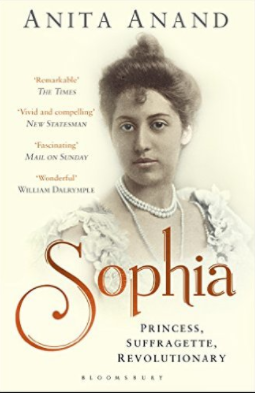|
|
The year is 1876. Queen Victoria has just been declared Empress of India. Princess Sophia is born in Belgravia to privilege and position in British society.
Granddaughter of the legendary ‘Lion of the Punjab’, Ranjit Singh, and goddaughter to Queen Victoria who doted on her flamboyant father, Duleep Singh, Sophia lived through key moments in modern history.
Indeed this book is more about history than personalities. The group felt that it was misleading to paint Sophia as such an influential personality using the descriptions ‘princess, suffragette, revolutionary’ on the part of the book's title. Our opinion is that Sophia was on the side lines of history, though maybe ahead of her time.
We agreed the book is well written, with Anita Anand fleshing out the detail to paint a full picture of events such as Sophia’s coming out ball at Queen Victoria’s court, Emily Davidson’s fatal act of running out on the track at the Derby and the suffragette march on Parliament on Black Friday in 1910.
Throughout her life, Sophia sought out and adopted new projects where she could contribute to society and keep busy. Examples of her involvement were raising money for the lascars (seamen from Asia), her support of the suffragette movement and her wartime charity efforts. |
|
Britain’s relationship with India is a fundamental part of this book. We learn how Britain acquired territory and wealth by stealth. And in the case of the seven-year old Duleep Singh, offering friendship and support, while marshalling troops on the border, that ultimately led to the British annexation of the Punjab.
Sophia made several trips to India, which raised her awareness of the kingdom and fortune that her father had signed away at eleven years old including the famous Koh-I-Noor diamond, which is now part of the Crown Jewels at the Tower of London. It also made her conscious of those less privileged than herself and introduced her to the rise of nationalism in the Indian continent.
The railways, legal system and civil service make a case for Britain operating as a force for good in India. However, many events described in this book testify to the opposite; how the people and resources of India were pawns in a much bigger, more brutal and hypocritical game. In Bihar the people were forced to grow indigo instead of edible crops causing famine in the region. In the Great War the Indian soldiers were cannon fodder with more than half the Indian army originating in the Punjab.
Sophia responded to the terrible conditions of the Indian troops by volunteering as a nurse and working at a hospital for the war wounded along the south coast of England near Brighton.
Living most of her life at her grace and favour residence at Hampton Court, Sophia, an Indian woman in British aristocratic society, was an outsider with insider status. Her role in the suffragette movement is testament to this, being welcomed to the Suffragette Fellowship (hardened activists) even though she had not spent a day in prison.
Ultimately it was Sophia’s involvement with the suffragette movement, which fashioned her ‘legacy’. She made a big impression on her goddaughter, Drovna, who she made promise ‘never, ever not vote’.
Despite her many projects, the cause Sophia most wanted to be associated with was ‘The Advancement of Women’ - her single ‘interest’ in her entry in Who’s Who.
Submitted by Margo Rosenberg Book Group 1
|
|





